Now that I've finished with my tale of the development of the British and American battleships as actually built, I can turn my attention to some of the cul-de-sacs along the way, design concepts that were considered and then bypassed for one reason or another. Probably the most interesting and certainly the most famous of these is the Maximum Battleship.
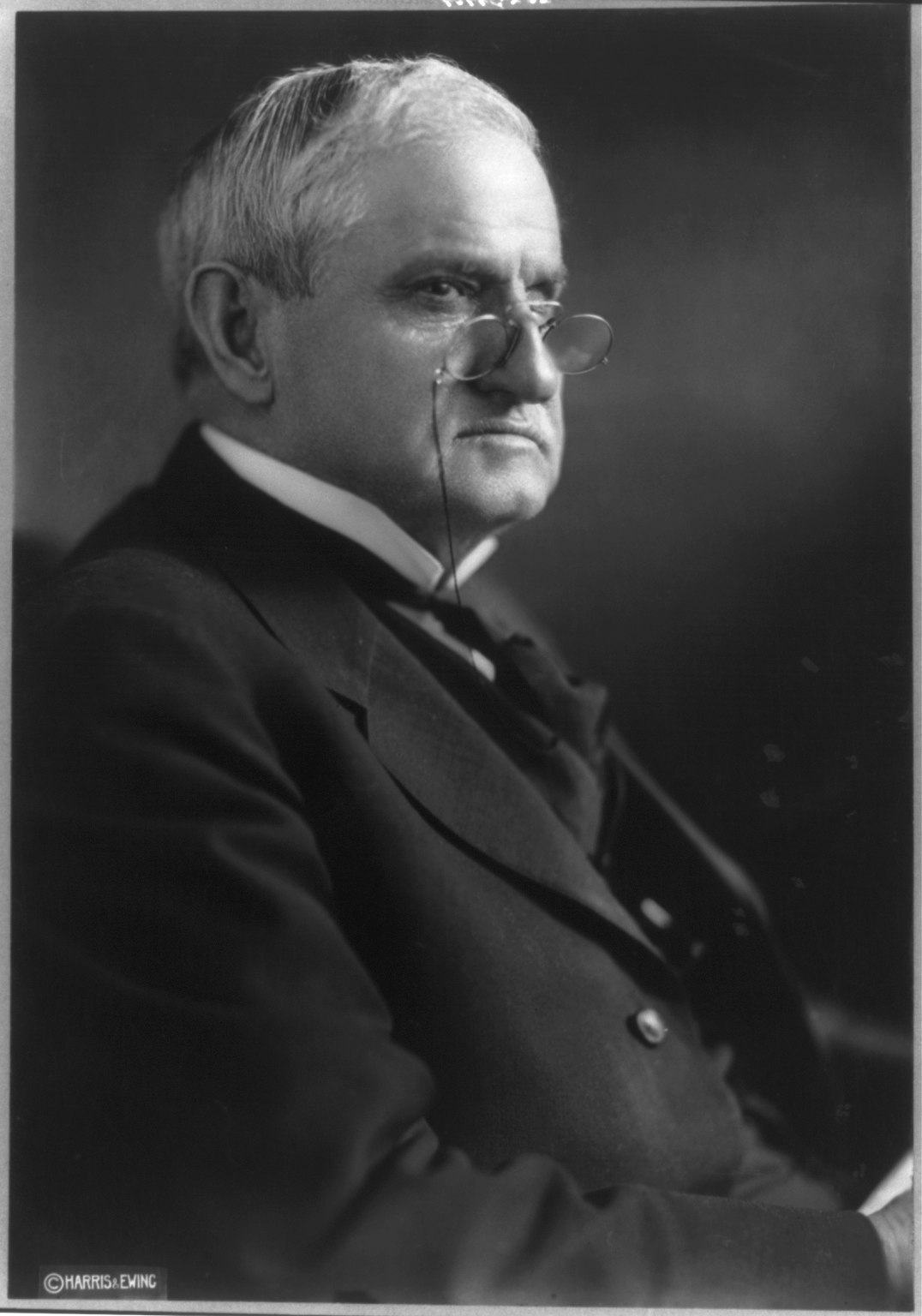
Benjamin Tillman
The maximum battleship was the brainchild of Senator Benjamin Tillman, a powerful member of the Senate Committee on Naval Affairs.1 In 1912, Tillman, exasperated with the continual growth of the ships the Navy was requesting, asked them to study the biggest battleship they could actually make use of, given the limitations of the existing docking facilities, most notably the Panama Canal, which was under construction and would open in two years. The first result was an enlarged version of Nevada: 38,000 tons, 12 14" guns, a 17" belt and 23 kts. The Bureau of Construction & Repair was horrified at the size of the resulting ship, which could only fit into two drydocks in the country, both on the West Coast. To bring size down, they cut speed to 20 kts, which saved 3,000 tons and enough length to fit the ship into drydocks on the East Coast.
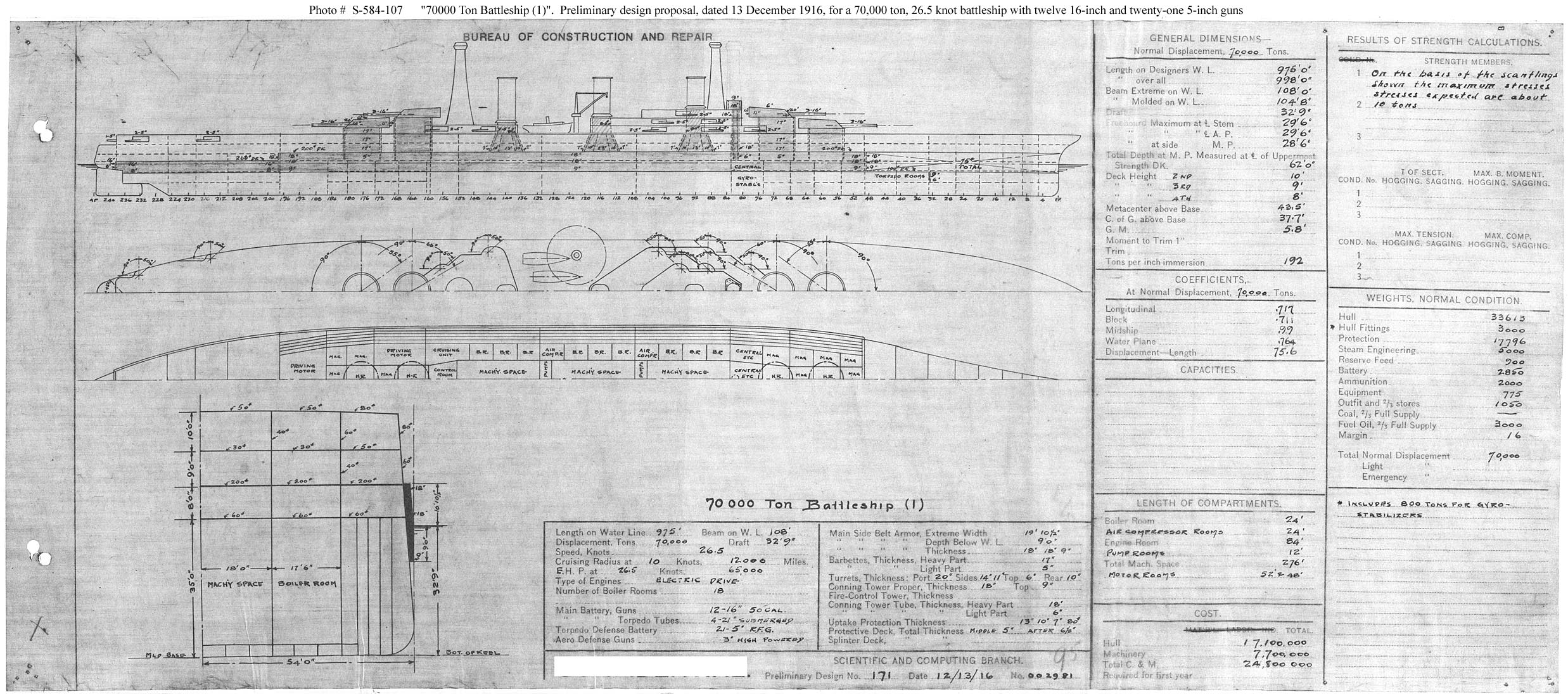
Design 1: 70,000 tons, 12 16" guns, 18" armor
Tillman was not happy. He believed that any future battleship needed to be able to make at least 25 kts, which C&R pointed out would mean a sacrifice of 4 guns and substantial protection, producing a battlecruiser instead of a battleship. The Secretary of the Navy, Josephus Daniels, was determined to hold down battleship growth, so Tillman had to bide his time. His chance came 4 years later, when Democrats had taken control of the Senate and he was now chairman of the Naval Affairs Committee. He asked for another investigation, and this time, the navy took things more seriously. The main limits of this series on length and beam were the Panama canal, at 975' and 108' respectively, while draft was limited by harbors to around 34'. At this point, C&R was working on the South Dakota class, and the resulting slate of four designs can be seen as extensions of those ships, with a base armament of 12 16" guns, 13"-7" belt and 3" deck armor, and turboelectric drive.
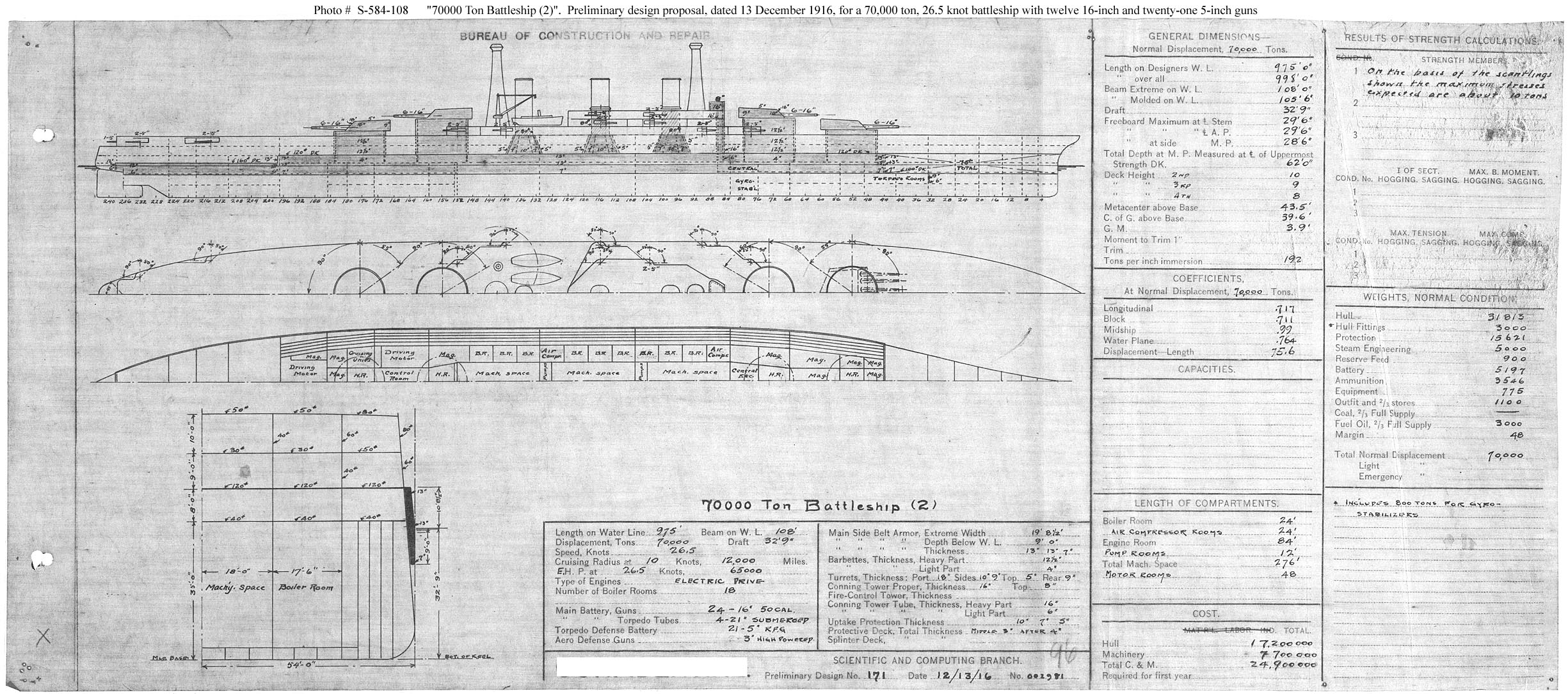
Design 2: 70,000 tons, 24 16" guns, 13" armor
The first two designs were each of 70,000 tons and capable of 26.5 kts. The rest of the tonnage went into bolstering either armor or firepower, with one ship having a belt of 18"-9", while the other saw the four triples of the base design replaced by sextuple turrets, each still carrying 16" guns. Both designs had serious and obvious problems. The armor-heavy one would have required plates considerably thicker than the US was able to produce at the time, while the very idea of a sextuple 16" turret is completely insane. Nobody ever built more than a quadruple turret, and the US had only limited experience even with triples at the time. The third design placed the emphasis on speed, a 63,500 ton ship with the standard armor and armament but capable of 30 kts. The last design was the largest, 80,000 tons and with the combined heavy armor and heavy armament of the first two designs, at a cost of only being able to make 25.2 kts.2
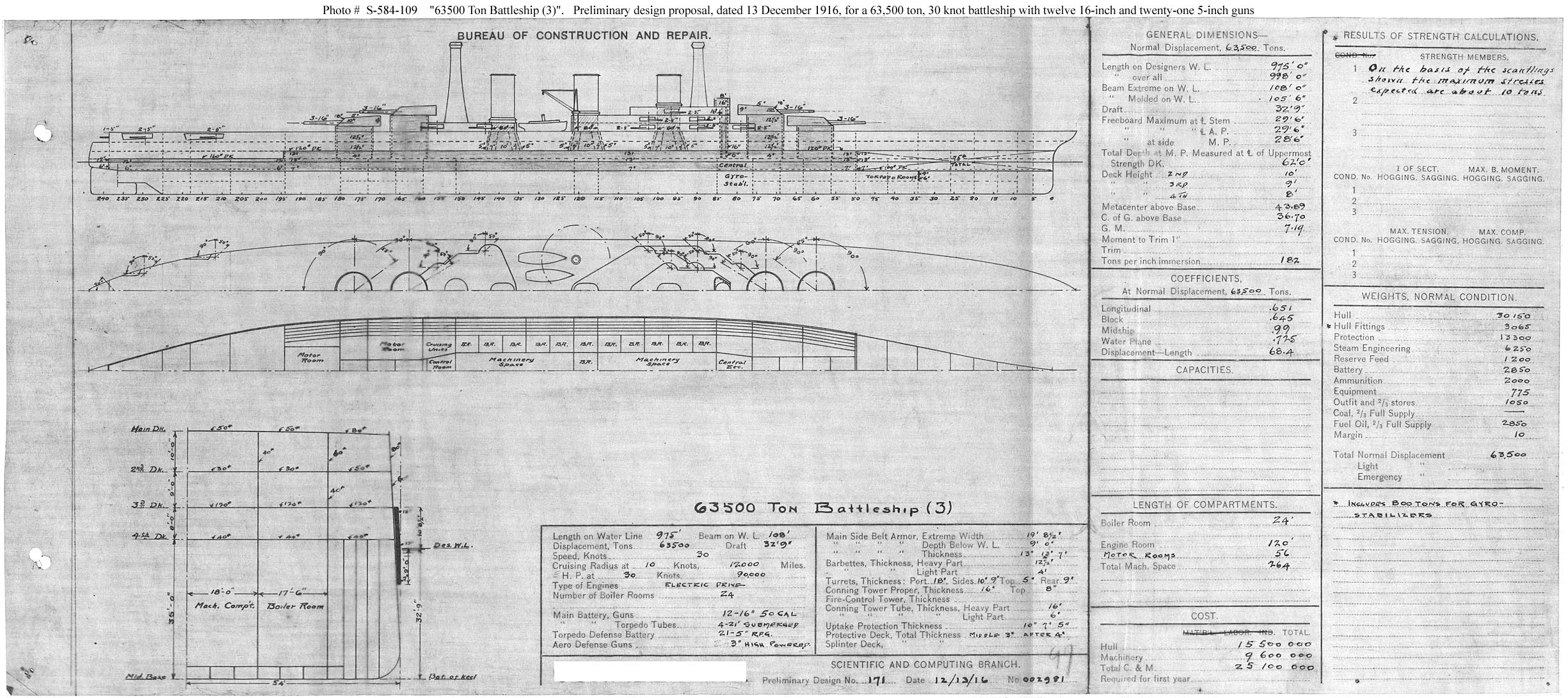
Design 3: 63,500 tons, 30 kts, 12 16" guns, 13" armor
In an attempt to make the design a tiny bit more sane, the Bureau of Ordnance suggested studies with an 18" gun instead of 16-inchers. Two were conducted, each based on design 4, but with the maximum belt thickness reduced to 16". One of them had five triple turrets, while the other had five twins and one triple. This arrangement is almost as bizarre as the sextuple turrets, and the most logical arrangement, four quads, wasn't explored at all.
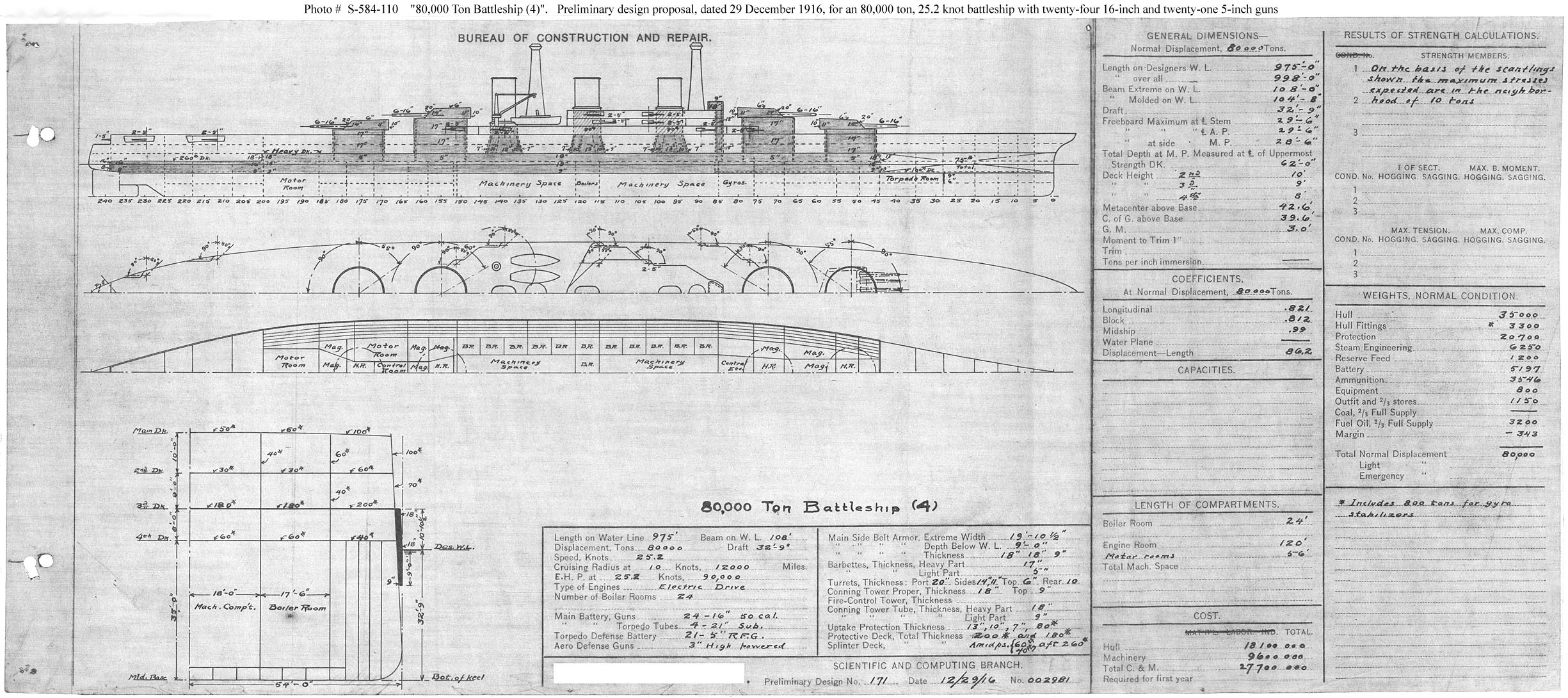
Design 4: 80,000 tons, 24 16" guns, 18" armor
The probable reason for some of the design silliness is that none of these designs were ever intended to be built. Even at best, one would have been about twice as expensive as a standard battleship, and there was fear of rendering all previous battleships obsolete, just as Dreadnought had rendered previous battleships obsolete.3 There were also logistical problems: while they could fit through the Panama Canal, they couldn't fit into most other drydocks, berths, and so on.
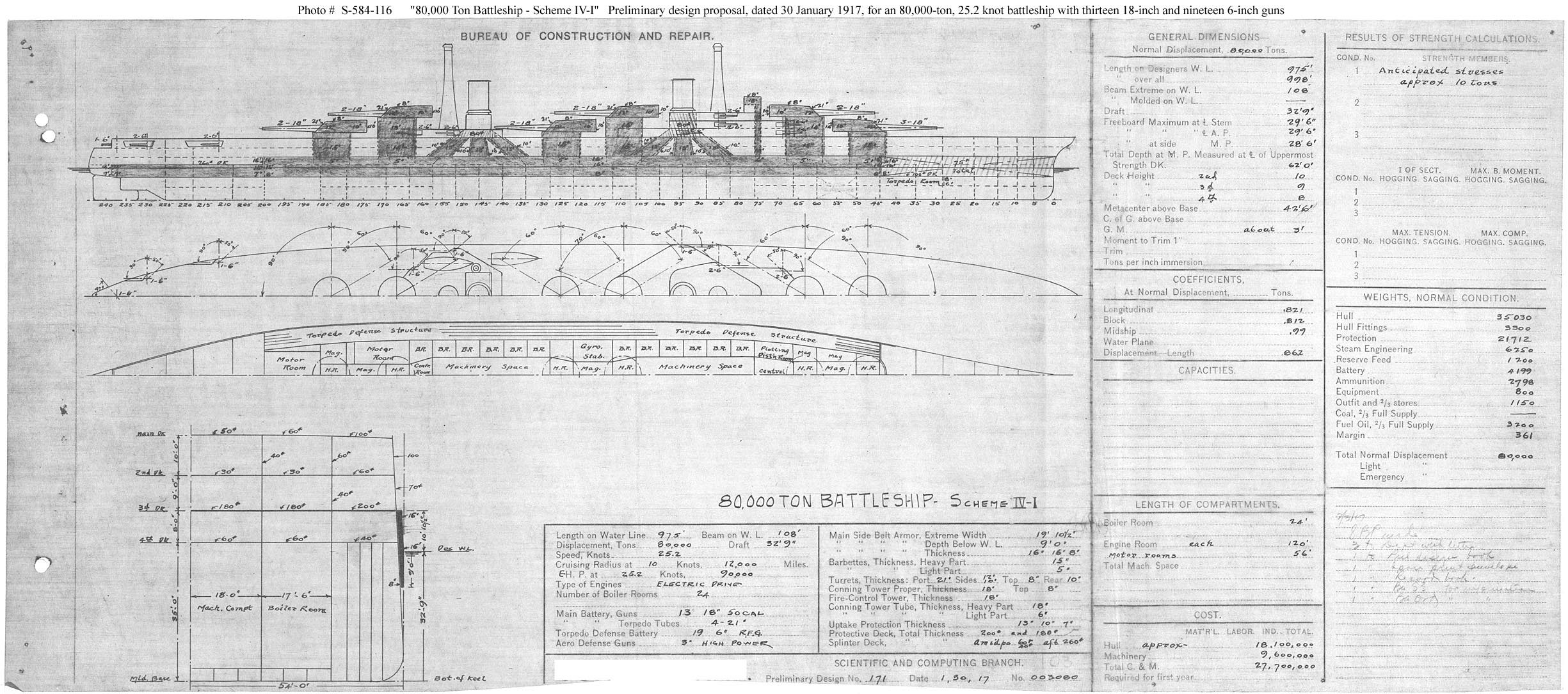
Design IV-1: 80,000 tons, 13 18" guns, 16" of armor
The Maximum Battleship is also of interest as the forerunner of the extremely large battleships contemplated a quarter-century later before and during WWII. In particular, the first two schemes are almost exactly the same tonnage as the Yamato class, the design of which was based off a similar analysis to the one Tillman requested. The Japanese believed that the US would never build a battleship too big for the Panama Canal, and thus designed the Yamatos to overmatch anything which could make that transit. The US planned to get around this problem in the Montana class by the simple expedient of installing a newer and larger set of locks on the Canal. But when comparing the Yamato to the American designs, one of the most striking things is the disparity in armament. The Maximum Battleships considered with 18" guns had either 13 or 15 guns, while Yamato mounted only nine, despite having similar speed and the benefit of technological progress that made many systems, most notably propulsion, lighter. Ultimately, this was the result of progress in air and underwater attack requiring defenses which soaked up a tremendous amount of weight. Yamato's deck, designed to cope with air attack and truly long-range gunfire, was 8-9", while even the heavy-armor Maximum Battleship's was only 5".
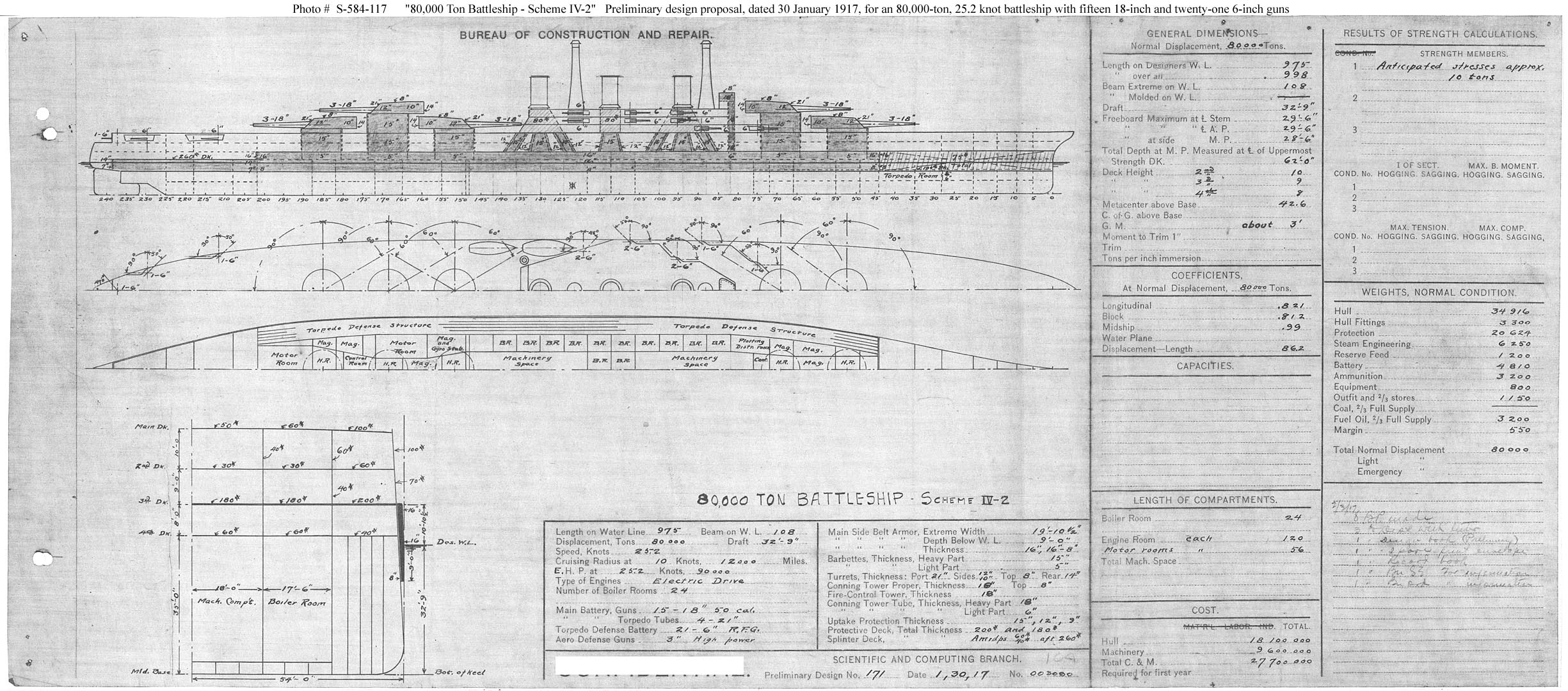
Design IV-2: 80,000 tons, 15 18" guns, 16" of armor
While it was never a serious proposal, the Maximum Battleship is a fascinating look at both the politics of warship procurement, and the fundamental limits on battleships in the late dreadnought era. Ships similar to these sketches, if probably less extravagant, might well have seen service if that era was not cut short by the Washington Naval Treaty.
1 Tillman is also remembered for being exceptionally racist even by the standards of South Carolina c.1900, gaining the nickname "Pitchfork Ben" for his aggressive speeches. Overall, not a nice man, but he did ask the Navy to produce some interesting battleship sketches. ⇑
2 A ship with more draft could be more efficient, and if the Panama Canal limit of 38' had been in effect, this ship could have made 28 kts. Another 10,000 tons was available if speed was held constant. ⇑
3 I will admit that the logic of this never made sense to me. If it's going to happen sooner or later, then spending extra money on ships that you think will be obsolete is stupid. ⇑

Comments
Sextuple turrets. Sextuple turrets. I did a double-take when I read that - surely you mean six turrets, not one turret with six 16-inch guns side-by-side, right? That's the sort of nonsense I'd expect to see in From the Depths or something.
Did anyone else try sextuple turrets, even on paper?
No, I mean six 16" guns in a turret. I don't know of any serious attention to the concept from any ordnance people, even in the US, but it's hilarious to think about.
The ridiculous number of guns, even when compared to the same sized Yamato class, brings to mind your early article that mentions how there are two types of navy. Navy's that have ships that sit in harbour, and occasionally go for a show of force demonstration cruise. And navys that actually spend their time sailing around the world's oceans and being used to project force. And how ships in the first sort of navy tend to have much bigger and more guns and other weapons. While the second sort of navy tend to prefer having fewer, smaller weapons in exchange for better weight distribution, the ability to actually man and use said weapons, more space on board, having more ammunition for practice, and other mere practical considerations. I guess that pure paper designs can be even more extreme on the "all show, no go" end of the scale.
Sextuple 16" turrets, pah. I give you my proposal for the battleship with the octuple, 18" turret. Well OK, the battleship that IS an octuple, 18" turret. Is disk-shaped, like silly Russian floating-saucer ironclads, da? Entire battleship is octuple 18" turret. Azipod propulsion, for aiming at enemy and also for steaming sideways so we can deliver proper broadsides at the enemy.
Granted, it could never transit Panama. But we only need to build one for each ocean, and no enemy would dare threaten us. Does anyone know if Senator Tillman's RFP is still open?
@doctorpat
I think there are several factors involved. The first is probably just the designers being kind of silly with their response to this request. "Hey, we've been asked for this absurd design, so let's give it sextuple turrets." The second is the one I gave, pointing out that heavy deck armor and underwater protection both take up a lot of weight. The third is that the design is simply too big for its guns. Agincourt is another example of this. The initial plan was to give that ship 13.5" weapons, but the Brazilians wanted compatibility with the 12" on their existing dreadnoughts, and so it got 7 turrets instead.
@John
You, sir, are a madman. Given the issues those ships had, I wouldn't be surprised if the guns weren't better propulsion than the azipods. And while the RFP is still open, the address is that of C&R, and NAVSEA refuses to accept messages on this topic.
My question is why nobody else thought like Tillman. Somewhere I saw a quote to the effect "I don't follow (run after?) my dreams, I predict where they'll go and meet them there." If the trend in battleship size was so obvious that people complained about it, the extrapolation should have been painfully obvious: sizes will keep growing (and they did, even despite the construction holiday) and next-year's-fashion ships will become second-line units in ~ a decade (and they would have, if the Great Anglo-American War of the Late '20s weren't called off). (Most obvious example: HMS Dreadnought, then ten years later, Jutland with 15" fast battleships.) If not for the treaty, a somewhat slower Montana-like ship would have been first-line for that war (or any war/arms-race in the late '20s, i.e. against any adversary), this was entirely predictable in the '10s, and it did make all the sense in the world to take this fact into account.
This could have been done even better if one knew what the right questions to ask were (e.g. my understanding is that even hypothetically, if battleship development could iterate without serious challenge from carriers, ~18" would have been where gun caliber increase would have stopped, for ballistics reasons); but even without that, why did nobody else think like that?
I will admit to not understanding why “it will make our current ships obsolete” is considered a good argument. If this is the way of the future, all you’re doing by continuing to build the old ships is making sure you’ll have even more obsolete ships when the change comes. But while that seems a knockdown argument against the anti-Dreadnought faction, I don’t think it applies as strongly here. Dreadnought was a pretty natural result of the drivers in place at the time, and Britain holding off would just mean that Japan and the US get them first, about when they did historically. But Tillman was proposing a radical leap years forward, and that’s very risky, because the trend lines may not hold. If you’d tried to do that in 1900, you’d have ended up with a truly enormous pre-dread that would be completely useless in 15 years. The Tillman ships would have been slightly better, although the initial batch of studies was conducted before the US figured out torpedo defenses, which might have been a problem, and there would have been no room to add blisters. Also, there’s more than one thing which sets the size of your battleships, and the designs produced would have meant spending a ton of money on infrastructure to support them.
Another good parallel to the Tillman ships is probably SS Great Eastern, which looks to me like the "generation jump" theory being played out in practice. And she was a failure in her intended role, although she gave good service as a cable-layer.
I agree that "it will make our current ships obsolete" isn't exactly a good strategy, but at the same time it seems like there are two big risks that mitigate against trying to do a triple jump into the future (though they're sort of contradictory):
"Dreadnought was a pretty natural result of the drivers in place at the time" Err, not at all. Even if Fisher got into something else and the South Carolinas came first, their all-big-gun layout reflected a change in doctrine (to long-range gunnery), and I think that any system that embodies a change in doctrine is non-obvious (or "natural"). Plus Fisher's network-centric warfare doctrine (which didn't pan out in the period). Better watertight integrity is the aspect which is not particularly related to any revision of doctrine.
"It will make our ships obsolete": the simple answer is a sunk cost fallacy. The more charitable justification is a bit of nested game theory: a game of chicken (sort of) to reset the score on a dollar auction (with nobody getting back what they bet), where the people who said this wanted to swerve.
Basically, assume that there's an Unspoken Schelling Fence Naval Tre... Gentlemen's Agreement limiting battleships to 12" or something. That arms race (dollar auction) has already been won/lost, thus neither side has much incentive to keep betting on that game. They could go and invest in social programs or something, if all sides (and there aren't that many) mostly keep to the unspoken treaty. (They can "cheat" by building ships slightly bigger as long as they use 12" guns.) Or they can start a new arms race of 14" ships (the outcome of which will override the previous) from zero and thus guarantee that it will be fiercely fought (since the benefit of the marginal battleship is much larger). If it's a foregone conclusion who would win that arms race, and it's the same as the winner of the previous one, then it's a completely foreseeable waste of everyone's time and money to play out the game with physical steel rather than metaphorical nerves of steel. If you trust that the other side can think through the same logic, and reach the same conclusion, and not be bastards who say in your face "yes, I'm wasting my money to force you to waste your money, neener neener", i.e. you trust them to swerve, then you might as well swerve yourself, and keep to the Unwritten Naval Tre... Gentlemen's Agreement.
Disagree. There are times when external factors (rising gun ranges and better fire control) will push for changes in doctrine, and Dreadnought was a pretty straightforward result of the changes taking place at the time. The Tillman ships would have been a much bigger departure, with serious risk of turning into white elephants due to lack of growth margin.
It did pan out pretty well at the Falklands, the only time it was really tested. The British did such a good job extinguishing the large-scale threat to trade that it's easy to overlook how big the threat was.
I think it's some of both, depending on what sort of change you have. Dreadnought is definitely on the sunk cost fallacy side. You might be able to hold off change for a few years, but it's coming, and pretty obviously so. Tillman is rather the opposite. You're looking at vaulting a long way down the track, and while you'll get some benefit from doing so, you also run the risk of creating a major white elephant.
LCS and DDG-1000 both seem pretty obvious examples of the dangers of what can happen when you make too large a leap in technology.
I'm not sure about the DDG-1000, there may have been an element of trying to build a ship with technology that wasn't yet mature, but I don't think that that is the principal problem with the LCS. The LCS (as I understand it) is a mash up of a mothership for unmanned systems, and a very fast ship for skirmishing with FIACs. The mothership role may require improved technology for its unmanned systems to be as effective as promised, and the very fast frigate role may be of questionable utility, but it's the combination that creates the real problem. You really want plenty of space for the mothership concept to be effective. I know Bean is less enthusiastic about Kalaat Beni Abbes, but that's very much my idea of what the LCS should have been. Trying to achieve speeds comparable to Le Fantasque with such a design is going to require major compromises, and I don't think any exciting new technology will change that.
I'd definitely put the DDG-1000 into the "too big a leap", particularly when you combine it with the fact that it was very much an extrapolation of where they thought things were going in the 90s, and and not really proofed against them being wrong about that. I really need to write about what was going on with the development of that program, although that's going to take a few more references.
@Alexander:
That is what the LCS is now; but at least for the first part, it is not what LCS was designed to be (the second part does seem to be at least partially what they thought it would do, even if it was kind of dumb).
The LCS was designed to be a baseline hull that could be rapidly convertible into either a mine warfare ship or an ASW escort. The MIW module is long dead; the ASW module continues to limp along, and probably will even be fielded before they start retiring the first hulls in a few years. But there is no more pretense of rapid convertibility, and even the ASW escort mission looks like it's going to be replaced by the new FFGs.
Even as far as the space provided by the mission bays, that is not a feature unique to the LCS. I can get that out of the EPF platforms (for all their problems) for significantly less cost and overhead (heck, I even get to keep the dumb speed requirement* as well).
LCS might end up being useful or worth the investment cost, and it might end up leading to better things a generation ahead...but it's certainly not a good example of trying to take a revolutionary leap forward in design and coming out ahead. One day, I hope someone gets to write a book about how and why the LCS program happened, but I worry they won't be able to really get enough documents to really discuss it since they will all be lost on corrupted .pst files or never properly kept anyway.
*-you can tell it's a dumb requirement with no real basis because it ends in a "0".
The LCS was originally meant to be a FAC but was enlarged to the point at which it could be at least minimally useful.
"Fast Attack Craft" generally refers to a vessel armed with antiship missiles (or sometimes torpedoes) capable of sinking larger warships, which was never a design goal of the LCS and even modest capabilities in that regard were added only well after the fact.
But it was expected from the start to serve as a something like a FAC-killer, with a Surface Warfare mission module equipped with guns and missiles optimized for the anti-small-craft role. I say "something like" a FAC-killer because for a long time the chosen weapons suite was optimized for engaging boats smaller and less capable than any traditional FAC. Still, definitely a Surface Warfare mission.
Also special-operations support and coastal patrol duties, so definitely more than just minesweeping + ASW. And in several of those roles, it was definitely meant to be a high-speed surface combatant that would chase down and engage enemy surface vessels in a high-speed nautical knife fight. You weren't going to win that contract with a 25-knot helicopter platform, however efficient and capable.
I'd point out that any modern warship is the result of a bunch of different actors all pushing their own position to get the final result. The LCS grew out of what was essentially an FAC proposal, but it ended up morphing into a weird hybrid of high-speed FAC-killer, multi-role support combatant, and helipad. I do intend to do a deeper dive into the design at some point in the relatively near future, but there's a book I need that still hasn't come in.
Well, thank you all for the LCS commentary, I look forward to the post. I find it slightly amusing that the discussion moved from 'The Maximum Battleship' with a huge battery heavy guns, to the LCS, with a single (very nice) 6 pounder. Quite a fun contrast Ü
I'm not convinced that the Tillman battleship designs (at least the earlier ones) were insane per se, more just ahead of their time. For instance, if you averaged Tillman I and Tillman III's specs, made it shorter and wider, and replaced the casemated secondary battery with dual-purpose turreted guns, you'd basically have the Montanas.
I'd also have to question the idea of a sextuple turret being insane. As long as you make the turret wide enough to accommodate six guns side by side, the guns shouldn't have to deal with any problems that don't already show up on a triple or quadruple turret (i.e., any turret with enough guns that at least one of them has other guns on both sides, i.e., anything other than a single or twin turret). Additionally, looking at the sketches of Tillman II and Tillman IV, they appear to adopt the same solution for their sextuple turrets as the French used for their quads (namely, two half-gun-number turrets welded together - siamesed twins in the French ships, and siamesed triples in the Tillmans), which reduces the problem to one of two triples flying in formation - and triple turrets were very much a known quantity even in 1916 (as long as you weren't the Royal Navy or the IJN).
@bean
As evidenced by the fact that several other navies were already laying down, or planning to lay down, uniform-main-battery battleships (e.g., the Nassaus, the South Carolinas, and [although they ultimately ended up being built as semidreadnoughts instead due to insufficient supplies of 12" guns] the Satsumas; additionally, a uniform-main-battery design was seriously considered, although ultimately rejected, for what ultimately became the Dantons) at the time, and that several classes of semidreadnoughts (with an all-big-gun main battery, but one of mixed caliber) were already in service (and more were under construction or on order) by then.